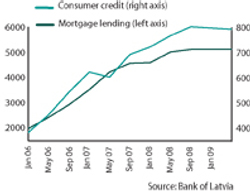After joining the EU in 2004, Latvia experienced rapid economic growth with annual GDP rates exceeding 10%, house prices increasing fourfold and income growth reaching 30% annually. No wonder it produced intensive levels of consumer spending.
Latvia’s service and construction sectors grew rapidly, but manufacturing was left lagging behind. Strong domestic demand and a disproportionate current account balance pushed inflation beyond the 10% threshold. But, at some point, the process spiralled out of control.
Advertisement
Downward spiral
The first signs of a downward spiral emerged in 2007. With the real-estate bubble about to burst, commercial banks introduced more conservative lending policies. In just a year, the economic boom was replaced by a crisis, which made foreign borrowing unavoidable. This economic slowdown affected GDP growth rates, which dropped all the way down from 10% in 2007 to 4.6% in 2008. The hardest hit were the demand-driven sectors, including retail, real estate and construction.
Rapidly growing income, coupled with easily accessible consumer credits and mortgage loans, produced huge imbalances. This high level of consumer spending could not be sustained. The resulting slump coincided with a major shift in the banks’ attitude to personal loans.
The previously widespread policy of lending without any in-depth research into a loan applicant’s credit history was suddenly replaced by a much more cautious approach. Together with an increase in value-added tax, this has profoundly influenced consumer trends. Latvia is likely to experience deflation continuing to the end of 2009 and beyond, despite changes in VAT and excise tax rates that will help to slow down the rate of deflation.
Ebb and flow of FDI
The Latvian economy is also experiencing an outflow of FDI. This is mostly the result of the global economic crisis, with companies redefining their goals and strategic markets.
At the same time, the Latvian government has been stabilising exports and promoting export guarantees and partial import substitution with locally manufactured goods. Latvia has been experiencing an FDI influx in the real estate, trade and financial sectors, and other industries are likely to benefit from FDI, too.
In 2009, Latvia’s economy entered a new economic phase, characterised by a sharp contraction in domestic demand, a drastic GDP dropdown by 10% or more and deflation. But lessons can be learnt from this and, provided the economy is well managed, it will eventually lead to structural improvements and substantial development.
Advertisement
Positive outlook
So is there a light at the end of the tunnel? The good news is that the economic outlook for Latvia, in particular, and for all three Baltic countries is looking more positive. According to the law of economic cycles, every downturn should be followed by a period of recovery.
Latvia maintains all the advantages that have been attracting investors since the country regained independence.
It is well-positioned between the West and East; it has a coastal infrastructure near the Baltic Sea; and it can provide a well-educated and skilled workforce. These factors will certainly help to maintain the appeal of the Latvian economy in the long term.
